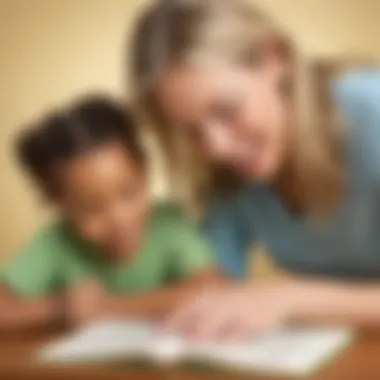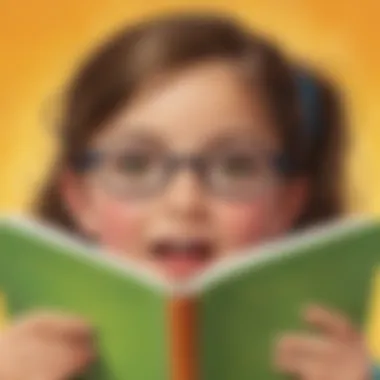Unleashing the Influence of TK Sight Words for Enhancing Children's Literacy Skills


Fun Activities Ideas
Sight words play a crucial role in children's literacy development, laying the foundation for reading and comprehension skills essential for academic success. Indoor activities can be seamlessly integrated with sight words to make learning engaging and fun for kids. By incorporating sight words into storybooks or interactive reading sessions, children can enhance their vocabulary and reading fluency while having a blast. Moreover, outdoor adventures provide a stimulating environment for incorporating sight words into nature walks, scavenger hunts, or outdoor reading sessions, fostering not only literacy skills but also a love for learning in young minds.
Arts and crafts activities offer a creative outlet for children to practice sight words through projects like word collages, sight word bingo, or incorporating sight words into coloring pages. These hands-on activities help solidify word recognition and spelling while nurturing fine motor skills and creativity. In addition, science experiments can be enriched by integrating sight words into lab instructions, creating a multisensory learning experience that cultivates a deeper understanding of both language and scientific concepts. Cooking and baking sessions present yet another opportunity to reinforce sight words through recipe reading and following instructions, merging literacy development with real-life skills.
Educational Games
By infusing sight words into math and logic games, children can sharpen both their numerical and literacy skills simultaneously. From counting games that incorporate sight words to word problem challenges, these engaging activities promote cognitive development while reinforcing word recognition. Language and vocabulary games elevate traditional wordplay by integrating sight words, whether through word scrambles, sight word memory games, or spelling bees. These games not only enhance language skills but also boost confidence and motivation in young learners.
STEM activities present a multifaceted approach to integrating sight words, bridging language arts with science, technology, engineering, and mathematics. By incorporating sight words into engineering challenges, science experiments, coding activities, or math puzzles, children can explore cross-disciplinary connections while honing their literacy skills. History and geography puzzles offer a unique way to immerse children in interdisciplinary learning, weaving sight words into map reading, historical timelines, or cultural exploration exercises. Interactive learning apps further enhance sight word acquisition through dynamic digital experiences that cater to diverse learning styles and preferences.
Seasonal and Holiday Activities
As special occasions unfold throughout the year, seasonal and holiday activities provide an excellent backdrop for integrating sight words into festive celebrations. Valentine's Day crafts can feature sight word messages of love and friendship, blending creativity with literacy in heartwarming projects. Halloween costume ideas can spark imaginative play while incorporating spooky sight words into costume themes, encouraging vocabulary expansion in a playful context. Thanksgiving cooking projects offer a hands-on way to bring sight words into the kitchen, as children engage in recipe reading and food preparation that celebrates gratitude and literacy.
Christmas decorations can be infused with sight words, from ornaments adorned with vocabulary to holiday cards with literary flair, merging the spirit of the season with language enrichment. New Year's resolutions for kids can include language goals tied to sight words, fostering a sense of accomplishment and progress in literacy development as the year unfolds.
Parenting Tips and Resources
To support children's literacy journey, parents and caregivers can encourage creativity by providing ample opportunities for imaginative expression through storytelling, art, music, or drama activities that incorporate sight words. Setting up a playful learning environment at home by creating a dedicated reading nook, stocking it with sight word books, games, and resources, can facilitate ongoing literacy engagement.
Balancing screen time and playtime is essential for holistic development, with parents encouraged to limit screen exposure and instead opt for interactive activities that involve sight words both digitally and offline. Building strong family bonds through shared reading sessions, word games, or storytelling moments can deepen parent-child relationships while fostering a love for language and learning.
Motivating kids to stay active in their literacy journey involves celebrating milestones, providing positive reinforcement, and creating a supportive home environment where reading and language activities are valued and integrated into daily routines. By engaging children in diverse literacy experiences and offering resources that cater to their unique interests and learning styles, parents can enrich their children's educational journey and nurture a lifelong love for reading and learning.


Fun Facts and Trivia
Beyond educational activities, exploring fun facts and trivia related to sight words can add an element of discovery and curiosity to children's literacy adventures. Delving into the animal kingdom unveils fascinating facts about vocabulary in the natural world, from animal names derived from sight words to unique terms used in zoology.
Discovering famous inventions stories intertwined with sight words can inspire children to connect language with innovation and history, fostering a deeper appreciation for the power of words. Exploring historical events for kids through the lens of sight words can offer insights into significant moments in time, from pivotal speeches to written records that shape our understanding of the past.
Venturing into mythical creatures explorations introduces fantastical vocabulary intertwined with legends and folklore, expanding children's word bank with imaginative terms and stories. Space adventures and discoveries linked to sight words can catapult young minds into the realms of astronomy, rocket science, and exploration, igniting curiosity and vocabulary growth through celestial encounters and scientific wonders.
Introduction to Sight Words
Sight words play a crucial role in developing children's literacy skills by enhancing their reading fluency and comprehension. In this article, we delve into the significance of incorporating sight words into educational practices. By understanding the essential nature of sight words, parents, teachers, and caregivers can create a strong foundation for children's reading abilities. This section will explore the key aspects of sight words, shedding light on their importance and practical implications for literacy development.
Definition of Sight Words
Sight words, also known as high-frequency words, are commonly encountered words that do not follow typical phonetic rules and must be recognized by sight. These words are foundational in early reading instruction as mastering them is vital for fluent reading. By grasping the definition of sight words, educators and parents can tailor educational strategies to meet children's learning needs effectively. Understanding the unique characteristics of sight words empowers individuals to design targeted literacy interventions that optimize learning outcomes.
Importance of TK Sight Words
TK sight words hold immense significance in children's literacy development as they form the basis of proficient reading skills. By emphasizing the importance of TK sight words, educators and parents can cultivate a strong reading foundation for children. Introducing TK sight words at an early stage enhances vocabulary acquisition and reading fluency, paving the way for improved comprehension. Incorporating these key words into educational activities provides children with the tools necessary for independent reading and boosts their overall literacy proficiency.
Effective Utilization of TK Sight Words
Effective utilization of TK sight words plays a pivotal role in enhancing children's literacy skills. By integrating these essential words into educational activities, children can develop a strong foundation in reading and writing. The strategic incorporation of TK sight words introduces young learners to commonly used words that are crucial for comprehension and communication. By focusing on these specific elements, educators and parents can create a conducive learning environment where children can thrive.
Incorporating Sight Words in Reading Activities


Incorporating sight words into reading activities is a fundamental aspect of promoting literacy development in children. When children encounter sight words frequently during reading exercises, they enhance their fluency and reading comprehension. By immersing children in texts that contain TK sight words, educators can reinforce recognition and recall of these words in context, fostering a deeper understanding of language structure and meaning. Reading activities integrated with sight words are integral to boosting children's reading proficiency and overall literacy skills.
Interactive Sight Word Games
Interactive sight word games are an engaging and effective way to reinforce learning and retention of TK sight words. By incorporating elements of fun and competition into educational games, children are motivated to actively participate in the learning process. Interactive games that involve recognizing, spelling, and using sight words in sentences not only make learning enjoyable but also improve children's retention of these essential words. Through interactive sight word games, educators can create a dynamic learning environment that encourages active participation and enhances children's vocabulary and language skills.
Sight Words in Writing Practice
Integrating sight words into writing practice is a key strategy for enhancing children's literacy skills. By encouraging children to use TK sight words in their writing exercises, educators promote vocabulary expansion and reinforce word recognition. When children consistently practice incorporating sight words into their written work, they develop confidence in using these words accurately and proficiently. Writing activities that incorporate sight words not only improve children's writing fluency but also enhance their overall literacy proficiency.
Strategies for Teaching TK Sight Words
In the realm of childhood literacy development, the Strategies for Teaching TK Sight Words play a pivotal role. These strategies serve as the bedrock for expanding children's vocabulary and comprehension skills. By delving into the nuances of sight words and their significance, educators and parents can unlock a world of possibilities for enhancing children's reading and writing abilities. To delve deeper into the Strategies for Teaching TK Sight Words means to tap into a reservoir of proven techniques that cater to individual learning styles and pace. From repetitive drills to interactive games, these strategies aim to make the learning process engaging and effective.
Multisensory Approaches for Learning Sight Words
When it comes to teaching sight words, a key aspect that stands out is the utilization of multisensory approaches. This method goes beyond traditional rote learning tactics by engaging multiple senses simultaneously. By incorporating visual, auditory, and kinesthetic elements, children are more likely to retain and recall sight words effectively. The multisensory approach not only caters to different learning styles but also fosters a deeper connection between the word and its meaning in a child's mind, contributing to long-term retention and application.
Incorporating Sight Words in Everyday Activities
One of the most impactful ways to reinforce sight word learning is by integrating them into everyday activities. Whether it's through household chores, mealtime conversations, or outdoor excursions, incorporating sight words seamlessly into daily routines can solidify a child's grasp on these essential words. This approach not only makes learning fun and practical but also emphasizes the real-world application of sight words, bridging the gap between classroom instruction and practical usage.
Personalized Learning Plans for Sight Words
Every child is unique, with individual learning needs and preferences. Therefore, personalized learning plans for sight words are indispensable in catering to each child's specific requirements. By tailoring teaching methods, pacing, and practice exercises to align with a child's strengths and weaknesses, educators and parents can optimize the learning journey. Personalized learning plans ensure that children are challenged appropriately, supported where needed, and ultimately empowered to accelerate their sight word proficiency in a manner that suits them best.


Measuring Progress and Reinforcement
In this section, we delve into the critical aspect of measuring progress and reinforcing sight word mastery in children. The assessment and tracking of a child’s development in sight word recognition play a pivotal role in enhancing their overall literacy skills. By systematically evaluating a child's growth in this area, educators and caregivers can tailor instructional approaches to suit individual learning needs effectively.
Measuring progress encompasses various methods, such as regular assessments, progress monitoring, and performance evaluations. These tools provide valuable insights into a child's comprehension and retention of sight words, allowing educators to identify strengths and areas requiring improvement. Furthermore, by quantifying progress, educators can adjust teaching strategies to optimize learning outcomes and ensure steady advancement.
Reinforcement strategies are crucial for solidifying sight word acquisition. Positive reinforcement, such as rewards for achieving milestones, can motivate children to engage actively with sight word activities. Additionally, creating a supportive learning environment that encourages practice and repetition fosters long-term retention of sight words. By employing a combination of verbal praise, tangible rewards, and engaging activities, educators can reinforce sight word mastery and sustain children's interest in literacy development.
Tracking developmental milestones in sight word proficiency involves monitoring a child's progression through different stages of learning. By observing a child's ability to recognize, read, and use sight words in context, educators can gauge their language proficiency and reading comprehension skills. Tracking developmental milestones also enables educators to set realistic goals, track progress over time, and adjust instructional strategies as needed to ensure continuous improvement and mastery of sight words.
Innovative Approaches to Sight Word Learning
In the realm of children's literacy development, Innovative Approaches to Sight Word Learning stand as a beacon of educational advancement. These modern strategies not only enhance traditional learning methods but also cater to the dynamic needs of young learners. By incorporating innovative tools and techniques, educators can create engaging and interactive experiences that resonate with tech-savvy children, fostering a profound understanding of sight words.
Technology Integration for Sight Word Practice
Technology Integration for Sight Word Practice revolutionizes the way children engage with learning materials. By leveraging digital platforms, educational apps, and online resources, students can immerse themselves in a visual and interactive learning environment. This approach not only enhances retention and engagement but also caters to varying learning styles, ensuring that every child can benefit from personalized and effective sight word practice.
Community Engagement for Sight Word Enrichment
Community Engagement for Sight Word Enrichment underscores the importance of a collaborative learning ecosystem. By involving parents, teachers, and peers in the educational journey, children can expand their understanding of sight words beyond classroom walls. Community initiatives, such as reading clubs, language workshops, and literacy events, create a supportive network that reinforces learning outcomes and nurtures a culture of continuous improvement.
Collaborative Learning Strategies for Sight Word Mastery
Collaborative Learning Strategies for Sight Word Mastery emphasize the power of teamwork and shared knowledge. By encouraging group activities, peer tutoring, and interactive exercises, educators foster a sense of camaraderie and mutual support among students. This collaborative approach not only enhances communication and social skills but also accelerates the pace of sight word mastery through collective learning experiences.
Conclusion
In the realm of children's literacy development, the Conclusion section serves as a pivotal point in synthesizing the crucial information encapsulated within this elaborate discourse regarding TK Sight Words. It functions as the cornerstone where all the insights and strategies elucidated throughout the article converge, offering a profound understanding of the significance and practical implications of incorporating sight words into educational practices. Through a meticulous analysis of the various methodologies and approaches discussed, the readers are primed for a nuanced comprehension of how leveraging TK sight words can substantially augment children's literacy proficiency.
Primary among the elements highlighted in this Conclusion is the intrinsic link between sight words and enhanced reading and writing skills among young learners. By immersing children in a scaffolded learning environment that emphasizes the identification and application of these fundamental words, educators and caregivers lay the groundwork for fostering robust language acquisition and comprehension abilities. Moreover, the Conclusion underlines the importance of adaptability and personalized learning interventions in the realm of sight word instruction. Recognizing that each child learns uniquely, tailoring teaching methodologies to suit individual learning preferences becomes paramount for ensuring comprehensive literacy development.
Another paramount aspect underscored in this Conclusion is the long-term benefits of early and consistent exposure to TK sight words. By instilling a strong foundational knowledge of these high-frequency words early on, children not only cultivate their reading fluency and vocabulary but also develop a deeper appreciation for language and communication. Additionally, the Conclusion sheds light on the role of reinforcement strategies in consolidating sight word mastery over time. Whether through interactive games, multisensory activities, or technology integration, reinforcing sight word retention is essential for sustaining literacy growth and proficiency.



